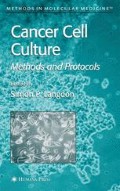Abstract
Sixty percent of all intracranial neoplasms are of glial origin. As a result of their infiltrative growth and heterogeneity, standard treatment (surgery, chemotherapy, and radiotherapy) is noncurative (2,2). Patient survival is poor and has not significantly improved over the past 20 years. It is a common belief in the neuro-oncology field that development of combination therapies for malignant brain tumors will be essential if improvement in survival is to occur (3,4). To test experimental single and multimodal therapies, animal and in vitro models of brain tumors are necessary.
Access this chapter
Tax calculation will be finalised at checkout
Purchases are for personal use only
References
Cavanee, W. K., Bigner, D. D., Newcomb, E. W., Paulus, W., and Kleihues, P. (1997) Diffuse astrocytomas. In: Kleihues, P. and Cavenee, W. K. (eds.) Pathology and Genetics of Tumours of the Nervous System, International Agency for Research on Cancer, Lyon, France, pp. 2–9.
Laws, E. R., Jr. (1998) Central nervous system tumors: what have we learned and where are we heading? Ca Cancer J. Clin. 48, 327–329.
Paul, D. B. and Kruse, C. A. (2001) Immunologic approaches to therapy for brain tumors. Curr. Neurol. Neurosci. Rep. 1, 238–244.
Virasch, N. and Kruse, C. A. (2001) Strategies using the immune system for therapy of brain tumors. In: Liang, B. C. (ed.) Hematology/Oncology Clinics of North America, Vol. 15, Saunders, Philadelphia, PA, pp. 1053–1071,.
Bigner, D. D., Bigner, S. H., Ponten, J., et al. (1981) Heterogeneity of genotypic and phenotypic characteristics of fifteen permanent cell lines derived from human gliomas. J. Neuropathol. Exp. Neurol. 40, 201–229.
Bakir, A., Gezen, F., Yildiz, O., et al. (1998) Establishment and characterization of a human glioblastoma multiforme cell line. Cancer Genet. Cytogenet 103, 46–51.
Helseth, E., Dalen, A., Unsgaard, G., Vik, R., and Helseth, A. (1989) Overexpression of the epidermal growth factor receptor gene in a human carcinoma cell line derived from a brain metastasis. J. Neuro-oncol. 7, 81–88.
Joy, A., Panicker, S., and Shapiro J. R. (2000) Altered nuclear localization of bax protein in BCNU-resistant glioma cells. J. Neuro-oncol. 49, 117–129.
Silbergeld, D. L., and Chicoine, M. R. (1997) Isolation and characterization of human malignant glioma cells from histologically normal brain. J. Neurosurg. 86, 525–531.
Kruse, C. A., Mitchell, D. H., Kleinschmidt-DeMasters, B. K., et al. (1992) Characterization of a continuous human glioma cell line DBTRG-05MG: growth kinetics, karyotype, receptor expression and tumor suppressor gene analysis. In Vitro Cell. Dev. Biol. 28A, 609–614.
Kruse, C. A., Varella-Garcia, M., Kleinschmidt-DeMasters, B. K., et al. (1998) Receptor expression, cytogenetic, and molecular analysis of six continuous human glioma cell lines. In Vitro Cell. Dev. Biol. 34, 455–462.
Westphal, M. and Meissner, H. (1998) Establishing human glioma-derived cell lines. Methods in Cell Biol. 57, 147–165.
Oakes, W., Friedman, H. S., Bigner, S. H., Bullock, N. H., and Bigner, D. D. (1990) Successful laboratory growth and analysis of CUSA-obtained medulloblastoma samples, J. Neurosurg. 72, 821–823.
Gjerset, R. A., Fakhrai, H., Shawler, D. L., et al. (1995) Characterization of a new human glioblastoma cell line that expresses mutant p53 and lacks activation of the PDGF pathway. In Vitro Cell. Dev. Biol. Animal 31, 207–214.
Dropcho, E. J. (2001) Novel chemotherapeutic approaches to brain tumors. In: Liang, B. C. (ed), Hematology/Oncology Clinics of North America, Vol. 15, Saunders, Philadelphia, PA, pp. 1027–1052.
Fuller, C. and Perry, A. (2002) Fluorescence in situ hybridization (FISH) in diagnostic and investigative neuropathology. Brain Pathol. 12, 67–86.
Meyer-Puttlitz, B., Hayashi, Y., Waha, A., et al. (1997) Molecular genetic analysis of giant cell glioblastomas. Am. J. Pathol. 151, 853–857.
Shapiro, J. R. (2001) Genetics of nervous system tumors. In: Liang, B. C. (ed.) Hematology/Oncology Clinics of North America, Vol. 16, Saunders, Philadelphia, PA, pp. 961–977.
Rempel, S. A. (2001) Molecular biology of nervous system tumors. In: Liang, B. C. (ed.) Hematology/Oncology Clinics of North America, Vol. 15, Saunders, Philadelphia, PA, pp. 979–1006.
Malden, L. T., Novak, U., Kaye, A. H., and Burgess, A. W. (1988) Selective amplification of the cytoplasmic domain of the epidermal growth factor receptor gene in glioblastoma multiforme. Cancer Res. 48, 2711–2714.
von Deimling, A., Louis, D. N., von Ammon, K., et al. (1992) Association of epidermal growth factor receptor gene amplification with loss of chromosome 10 in human glioblastoma multiforme, J. Neurosurg. 77, 295–301.
Fults, D., Brockmeyer, D., Tullous, M. W., Pedone, C. A., and Cathon, R. M. (1992) p53 mutation and loss of heterozygosity on chromosome 17 and 10 during human astrocytoma progression. Cancer Res. 52, 674–679.
Author information
Authors and Affiliations
Editor information
Editors and Affiliations
Rights and permissions
Copyright information
© 2004 Humana Press Inc., Totowa, NJ
About this protocol
Cite this protocol
Gomez, G.G., Kruse, C.A. (2004). Isolation and Culture of Human Brain Tumor Cells. In: Langdon, S.P. (eds) Cancer Cell Culture. Methods in Molecular Medicine™, vol 88. Humana Press. https://doi.org/10.1385/1-59259-406-9:101
Download citation
DOI: https://doi.org/10.1385/1-59259-406-9:101
Publisher Name: Humana Press
Print ISBN: 978-1-58829-079-3
Online ISBN: 978-1-59259-406-1
eBook Packages: Springer Protocols

